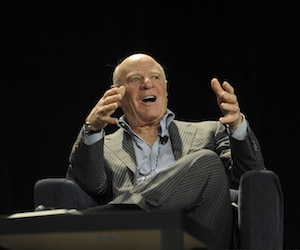Brands
The State of the Content Industry
From  Napster to Craigslist, Netflix to mommy blogs, perhaps no industry has been as severely disrupted in the past two decades as media.
Napster to Craigslist, Netflix to mommy blogs, perhaps no industry has been as severely disrupted in the past two decades as media.
Content continues to evolve at a rapid pace, changing the way information is compiled, consumed, shared and monetized. At the 2012 SXSW Interactive festival, media mogul Barry Diller offered some words of warning to those unprepared for the sea-change: “Unless you are adapting every day to what is possible, you really will be wiped away.”
At the forefront of this shift is the re-emergence of original, quality content and the surge in brands acting as publishers. Add to this changing landscape a redefining of journalism, shaped by social media, and the latest disruption in the broadcast industry, and media analysts see an industry that is both exciting and unsettling.
Original Quality Content Is Taking Back the Web
Katrina Wong, vice president of marketing at Socialbakers, a social media statistics portal, says now is a particularly exciting time for the content industry.
“Companies and individuals cannot underestimate the value of quality content,” Wong says. “The most successful companies… are those that are able to relate their product, message or personnel to more pertinent industry trends.”
Loyalty is the new currency in online publishing. No longer are SEO loopholes the paths to content discovery. Relevant, engaging and rewarding content brings impressions through social media and builds fans.
Consumers may look elsewhere, and today Google may point them elsewhere if a Website doesn’t put an emphasis on fresh, original content, according to Internet marketer Chris Horton.
“People can’t stop talking about the tech giant’s dramatic shift in favor of fresh and original online content for its search engine,” Horton writes in a recent blog post.
Creating compelling and useful content will likely influence Website rankings more than any of the other factors discussed in Google’s SEO best practices, according to Horton.
Google favors fresh and original content for three reasons: to improve user experience, refine ad targeting and create artificial intelligence (AI) knowledge graphs, Horton says.
In other words, content farms are so 2010.
Brands are Driving Business Value by Becoming Publishers
Brands are finding new, unique ways to use content and social media to drive serious business value.
“Social media is not about quantity or spamming users. In fact, it is the exact opposite. What separates those [brands] with millions of fans, versus those that fall on their face, is the ability to focus on providing meaningful content,” Wong says.
The surge in brand publishing is due in large part to the consumer hype of social media, but some brands are finding content a cost-effective alternative to ads.
Parker Ward, digital content manager at Weber Shandwick, recently told Advertising Age that stats show effective content costs less to bring a visitor to a brand than display advertising.
Journalists are Building Careers Out of Social Media
Those who aspire to carry on the tradition of journalism are alive and well. Yet Robert Niles of the Online Journalism Review, armed with some bleak statistics on the newspaper industry, calls print journalism, and newspapers in particular, the fastest-dying industry in America.
“As far as jobs go, this is – literally – the worst part of the worst industry in the worst economy since the Great Depression,” he says.
And on the other end of the job spectrum?
“Take a look at the top three growing industries over the past five years. There’s the Internet at No. 2 and Online Publishing at No. 3. That’s the future of journalism education right there,” he says.
Breaking news, once under the exclusive dominion of journalists, has broken free.
“We’re seeing normal consumers (not journalists) break major news via sites like Facebook and Twitter because social media has torn down the editorial walls that once contained public information,” Wong says.
However, social media and digital content is breathing new life for journalists as well. The most trusted journalists now break news and get scoops via social media, she says.
Journalist directory Muck Rack, for example, monitors and ranks journalists’ social media activity in real time and shows that journalists are among the most active and followed users on Twitter, apart from celebrities.
Broadcast Is the Next Big Disruption
Barry Diller, the man responsible for, among other accomplishments, greenlighting “The Simpsons” while running Fox more than 20 years ago, has returned his focus to broadcast television. But this time he’s looking to upend the status quo with the introduction of a Web-based television service called Aereo.
“The closed hegemony of cable, etc., is going to break up over time. People are going to access content a la carte,” Diller told Ali Velshi at SXSW.
Aereo is delivered through quarter-inch antennas that are placed in data centers. The service uses the existing signal in a city and allows consumers to bypass the costs of cable and satellite service.
“Behind the simplicity is a lot of technology,” Diller says. “So Aereo is really a brilliant end-run around the TV licensing and rights issues.”
Hulu CEO Jason Kilar, during an interview with Charlie Rose, predicted this impending disruption of the TV industry.
“The Internet is going to have a bigger impact on content creators than the television ever had,” he says. “And by the way, I think there’s going to be a number of winners. This is an immense, immense industry.”
Image courtesy of Merrick Ales Photography
Get better at your job right now.
Read our monthly newsletter to master content marketing. It’s made for marketers, creators, and everyone in between.




